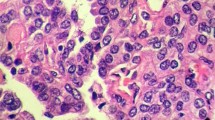Abstract
It has been reported that both polygonal and cuboidal cells in pulmonary sclerosing hemangioma (PSH) are monoclonal in origin and represent a variable differentiation from a common progenitor cell. However, it remains unclear about the clonality of the entire PSH lesion composed of these two types of cells. Thus, we analyzed the clonality of 22 cases of PSH and the relationship between the entire PSH and two types of cells using laser microdissection and X-chromosomal inactivation mosaicism and polymorphism at the phosphoglycerate kinase (PGK) and androgen receptor (AR) loci in female somatic cells. The results demonstrated all 22 cases of PSH showed typical histopathologic characteristics, including characteristic round or polygonal cells within the stroma and surface cuboidal cells lining the papillary projections or cystic spaces. The rates of polymorphism were 31.8% (7/22) and 86.3% (19/22) for the PGK and AR gene, respectively. After digestion by Hpa II or Hha I, one of two PCR amplification bands disappeared from all the samples, while the other band was retained, indicating neoplastic characteristics. Thus, we concluded that the entire PSH lesion, polygonal and cuboidal cells were neoplastic hyperplasia and originated from a common progenitor cell.





Similar content being viewed by others
References
Liebow AA, Hubbell DS. Sclerosing hemangioma (histiocytoma, Xanthoma) of the lung. Cancer. 1956;9:53–75.
Miyagawa-Hayashino A, Tazelaar HD, Langel DJ, Colby TV. Pulmonary sclerosing hemangioma with lymph node metastases: report of 4 cases. Arch Pathol Lab Med. 2003;127:321–5.
Yano M, Yamakawa Y, Kiriyama M, Hara M, Murase T. Sclerosing hemangioma with metastases to multiple nodal stations. Ann Thorac Surg. 2002;73:981–3.
Noguchi M, Kodama T, Morinaga S, Shimosato Y, Saito T, Tsuboi E. Multiple sclerosing hemangioma of the lung. Am J Surg Pathol. 1986;10:429–35.
Devouassoux-Shisheboran M, Hayashi T, Linnoila RI, Koss MN, Travis WD. A clinicopathologic study of 100 cases of pulmonary sclerosing hemangioma with immunohistochemical studies: TTF-1 is expressed in both round and surface cells, suggesting an origin from primitive respiratory epithelium. Am J Surg Pathol. 2000;24:906–16.
Katakura H, Sato M, Tanaka F, Sakai H, Bando T, Hasegawa S, Nakashima Y, Wada H. Pulmonary sclerosing hemangioma with metastasis to the mediastinal lymph node. Ann Thorac Surg. 2005;80:2351–3.
Niho S, Suzuki K, Yokose T, Kodama T, Nishiwaki Y, Esumi H. Monoclonality of both pale cells and cuboidal cells of sclerosing hemangioma of the lung. Am J Pathol. 1998;152:1065–9.
Dacic S, Sasatomi E, Swalsky PA, Kim DW, Finkelstein SD, Yousem SA. Loss of heterozygosity patterns of sclerosing hemangioma of the lung and bronchioloalveolar carcinoma indicate a similar molecular pathogenesis. Arch Pathol Lab Med. 2004;128:880–4.
Wang EH, Dai SD, Qi FJ, Hong-Tao X, Wei Q. Gene expression and clonality analysis of the androgen receptor and phosphoglycerate kinase genes in polygonal cells and cuboidal cells in so-called pulmonary sclerosing hemangioma. Mod Pathol. 2007;20:1205–8.
Pareja MJ, Vargas MT, Sanchez A, Ibanez J, Gonzalez-Campora R. Cytogenetic study of a pulmonary sclerosing hemangioma. Cancer Genet Cytogenet. 2009;195:80–4.
Gong L, Zhang W, Su Q. Clonal status of fibrous dysplasia. Pathology. 2008;40:392–5.
Su Q, Liu Q, Wang SF. Clonality analysis technology based on X-chromosome genetic polymorphism and application. Zhonghua Bing Li Xue Za Zhi. 2002;31:162–4.
Lyon MF. X-chromosome inactivation and developmental patterns in mammals. Biol Rev Camb Philos Soc. 1972;47:1–35.
Acknowledgments
The study was supported by the National Natural Science Foundation of China (N0.30800417 and No.30672013) and the National Basic Research Program (973 Program) of China (No. 2009CB521705).
Conflict of interest statement
We declare that we have no conflict of interest.
Author information
Authors and Affiliations
Corresponding authors
Additional information
Li Gong and Kai-Xi Ren contributed equally to this study.
Rights and permissions
About this article
Cite this article
Gong, L., Ren, KX., Li, YH. et al. Determination of clonal status of pulmonary sclerosing hemangioma with X-chromosome inactivation mosaicism and polymorphism of phosphoglycerate kinase and androgen receptor genes. Med Oncol 28, 913–918 (2011). https://doi.org/10.1007/s12032-010-9539-7
Received:
Accepted:
Published:
Issue Date:
DOI: https://doi.org/10.1007/s12032-010-9539-7




